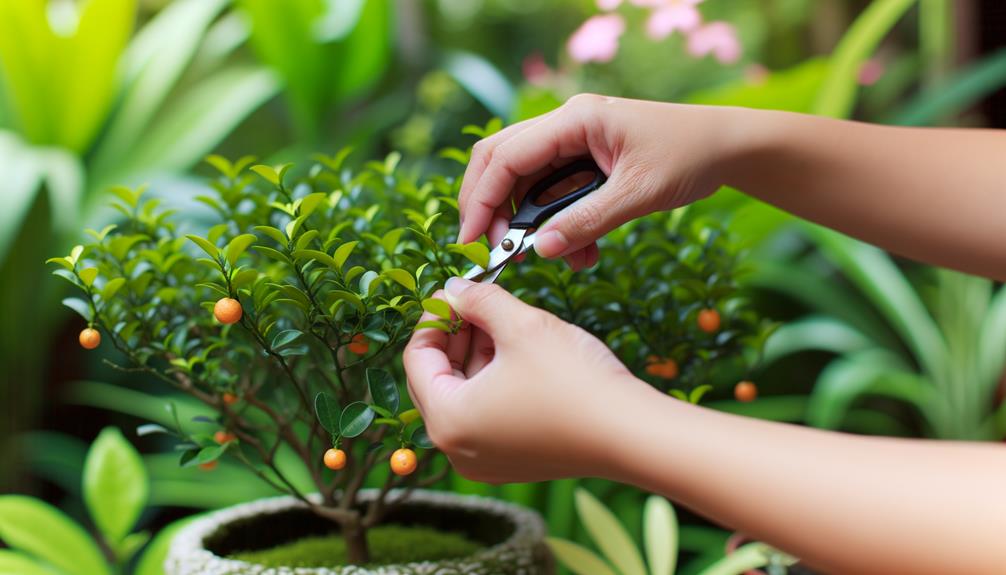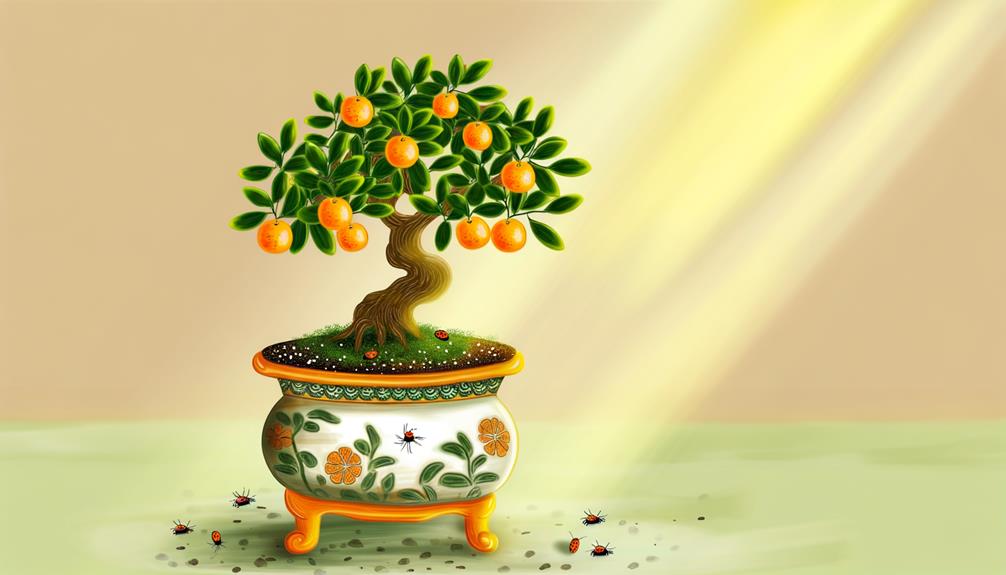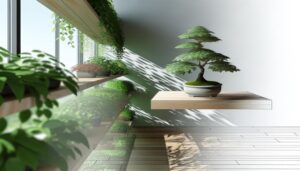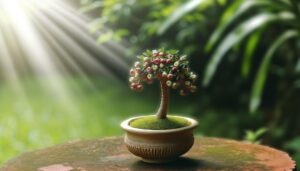How You Can Bonsai an Orange Tree Step by Step
Yes, you can bonsai an orange tree. Choosing the right variety is important, with Flying Dragon and Calamondin being ideal due to their compact growth habits.
Essential tools like bonsai shears, concave cutters, and high-quality bonsai wire are necessary for precise branch training. Start with meticulous root pruning and a well-draining soil mix to guarantee proper development.
Regular pruning of branches and leaves maintains balance and light penetration. Adequate watering, balanced fertilization, and vigilant pest control are essential for health.
Seasonal care, including repotting and protection from frost, enhances longevity. Explore further to master advanced techniques and maintenance.

Key Takeaways
- Yes, you can bonsai an orange tree using suitable varieties like Calamondin or Flying Dragon.
- Proper tools and materials, including bonsai shears and specialized soil, are essential for success.
- Strategic pruning techniques balance canopy and root growth, enhancing overall health.
- Appropriate wiring techniques help shape and train branches, ensuring structural integrity.
- Consistent maintenance, including proper watering, fertilizing, and pest control, is crucial for a healthy orange bonsai.
Choosing the Right Variety

Selecting the appropriate variety of orange tree for bonsai cultivation is essential, as it determines the tree's adaptability, growth habits, and overall success in a constrained environment.
Dwarf varieties like Calamondin (Citrus mitis) and Flying Dragon (Poncirus trifoliata) are particularly suitable due to their compact growth and tolerance to pruning. These varieties exhibit smaller leaves and fruit, which are advantageous in maintaining proportional aesthetics.
Additionally, considerations for climate compatibility and pest resistance are paramount. Cultivars that thrive in the local climate and demonstrate resilience to common pests will reduce the need for intensive care.
Genetic predisposition to smaller root systems further enhances the feasibility of container cultivation, ensuring that the orange bonsai remains healthy and vigorous over time.
Essential Tools and Materials
Equipping oneself with the appropriate tools and materials is essential to the successful cultivation of an orange tree bonsai.
Necessary tools include sharp bonsai shears for precise pruning, concave cutters for reducing branch scars, and wire cutters for shaping branches. High-quality bonsai wire, available in different gauges, is vital for branch training.
A specialized bonsai soil mix, typically comprising akadama, pumice, and lava rock, guarantees proper drainage and root aeration. Additionally, a well-draining bonsai pot with adequate drainage holes is indispensable. Root rake and tweezers facilitate root management and debris removal.
Preparing the Orange Tree

Preparing an orange tree for bonsai requires selecting a variety known for its adaptability to container growth, such as the Calamondin or Dwarf Valencia.
Initial potting techniques involve careful root pruning and placement in a well-draining soil mix to establish a robust foundation.
Ensuring proper anchorage and soil aeration is critical for the tree's long-term health and development.
Selecting Suitable Orange Varieties
When choosing suitable orange varieties for bonsai cultivation, it is important to factor in dwarf or semi-dwarf cultivars that exhibit controlled growth habits and adaptability to container environments.
Varieties such as 'Calamondin' (Citrofortunella microcarpa) and 'Trovita' (Citrus sinensis) are particularly recommended due to their compact growth and vigorous fruiting potential. These cultivars are well-suited for bonsai due to their smaller leaf size and manageable root systems.
Additionally, selecting varieties that are naturally resistant to common pests and diseases will enhance their longevity and aesthetic appeal. Ensuring the chosen variety can thrive in the intended climate and light conditions will further optimize growth and maintenance.
Proper selection is foundational to achieving a successful orange bonsai.
Initial Potting Techniques
Establishing a strong foundation for your orange bonsai necessitates careful attention to initial potting techniques, ensuring ideal root health and structural integrity.
Begin by selecting a shallow, well-draining bonsai pot to prevent waterlogged roots. Prepare a high-quality bonsai soil mix, combining akadama, pumice, and lava rock in equal parts to foster aeration and best moisture retention.
Gently prune the orange tree's roots, removing any damaged or excessively long roots to encourage a compact root system. Position the tree centrally in the pot, spreading the roots evenly. Secure the tree using bonsai wire to anchor it firmly.
Potting Your Orange Bonsai
Potting your orange bonsai requires thoughtful consideration of the pot's size and material to guarantee proper growth and stability.
The soil composition must be meticulously selected to provide sufficient nutrients while facilitating ideal drainage.
Additionally, root pruning techniques are essential to maintain the tree's health and promote a compact root system.
Choosing the Right Pot
Choosing the right pot for your orange bonsai is crucial for guaranteeing proper root development and overall plant health. The pot must provide adequate space for root expansion while maintaining the tree's characteristic dwarf size. An ideal bonsai pot should be shallow yet wide enough to facilitate lateral root growth.
Make sure the pot has enough drainage holes to prevent waterlogging, which can lead to root rot. The pot's material—such as ceramic, plastic, or terracotta—should be selected based on its durability and thermal properties, as these impact soil temperature and moisture retention.
Additionally, the pot's aesthetic should complement the orange bonsai's form, enhancing its visual appeal without overshadowing its natural beauty.
Soil and Drainage Needs
The success of an orange bonsai hinges on utilizing a well-draining soil mix that balances moisture retention with aeration to promote healthy root development.
A suitable substrate should incorporate components such as akadama, pumice, and lava rock, which enhance drainage and prevent waterlogging. This composition guarantees that the roots have access to oxygen, essential for metabolic processes, while retaining sufficient moisture to support growth.
Additionally, incorporating organic matter like pine bark can improve nutrient availability and microbial activity. Ensuring that the bonsai pot has adequate drainage holes is crucial to prevent root rot and other water-related issues.
Consistent monitoring of soil moisture levels and adjusting watering practices accordingly will further optimize the health and vigor of your orange bonsai.
Root Pruning Techniques
Proper root pruning techniques are essential for maintaining the health and compact growth of your orange bonsai, ensuring the tree develops a balanced and aesthetically pleasing root system.
Begin by carefully removing the tree from its container and gently loosening the soil around the roots. Trim away approximately one-third of the root mass, focusing on eliminating thick, woody roots while preserving finer feeder roots. Utilize sterilized, sharp bonsai shears to make clean cuts, preventing the risk of pathogen entry.
Repot the tree in fresh, well-draining bonsai soil, ensuring the roots are evenly spread. Water thoroughly post-repotting to settle the soil and provide hydration.
Regular root pruning, typically every two to three years, is essential for sustaining vigor and preventing root-bound conditions.
Pruning Techniques

Pruning, a crucial aspect of bonsai cultivation, involves meticulously trimming branches, leaves, and roots to maintain the desired aesthetic form and promote healthy growth in the orange tree.
Strategic branch reduction is vital to balance the canopy and enhance light penetration, thereby stimulating robust photosynthesis. Selective leaf pruning reduces transpiration stress and concentrates energy on essential growth areas. Root pruning, executed concurrently with branch trimming, guarantees the root ball remains compact and vigorous, preventing root-bound conditions.
Utilize sterilized, sharp bonsai shears to minimize tissue damage and prevent pathogen transmission. Timing is critical; perform major pruning during dormancy to minimize stress and encourage recovery. Regular maintenance pruning throughout the growing season keeps the tree's structure refined and health optimized.
Wiring Your Bonsai
Wiring is a crucial technique in shaping your orange tree bonsai, requiring careful selection of suitable wire types, such as aluminum or copper, to maximize flexibility and support.
Mastery of wiring techniques, including anchoring and coiling, is essential to guide branch growth without causing excessive stress or damage.
Timely removal of the wire is equally crucial to prevent scarring and to preserve the tree's health and aesthetic form.
Choosing Appropriate Wire
Selecting the right wire for shaping your bonsai is important, as it directly influences the tree's growth and aesthetic development. For an orange tree bonsai, annealed copper and anodized aluminum are the two main options. Annealed copper provides greater strength and is ideal for more rigid branches, while anodized aluminum is easier to handle and suitable for more delicate parts.
The wire gauge should be approximately one-third the thickness of the branch being trained to ensure adequate support without causing harm. It's vital to regularly check the wire for signs of cutting into the bark, which can hinder growth and cause scarring. By choosing the appropriate wire, you improve both the structural integrity and visual appeal of your bonsai.
Wiring Techniques Explained
One critical aspect of wiring your bonsai involves understanding the directional flow of each branch to guarantee shaping and minimal stress on the tree. Employing proper wiring techniques is paramount for guiding the growth patterns of your orange bonsai. Aluminum and copper wires are commonly used, with thickness varying based on branch rigidity. Initiate wiring from the trunk, spiraling outward in a 45-degree angle to support natural growth and prevent breakage. A dual-wire technique may be necessary for thicker branches, ensuring even pressure distribution.
| Technique | Description |
|---|---|
| Single Wiring | Applying one wire to a single branch for basic shaping. |
| Double Wiring | Wrapping two branches with one wire for balanced shaping. |
| Anchor Wiring | Securing wire to the pot to stabilize lower branches. |
| Guy-Wiring | Using tension wires to pull branches into desired positions. |
| Loop Wiring | Creating loops around the trunk or branches to guide specific growth paths. |
Employ these techniques with precision to cultivate an aesthetically pleasing and healthy bonsai orange tree.
Time to Remove
Determining the best time to remove the wiring from your orange bonsai is essential to prevent damage and make sure the tree maintains its intended shape. Ideally, the wires should be removed once the branches have set in their new position, typically within 3-6 months.
Monitor the tree closely for signs of wire cutting into the bark, which indicates the need for immediate removal to avoid scarring. Carefully unwire the branches, ensuring no abrupt movements that could cause breakage.
If the desired shape is not yet achieved, reapply new wiring with appropriate adjustments. Regular inspection and timely removal are important to maintaining the health and aesthetics of your orange bonsai, ensuring its longevity and continued growth.
Watering Requirements

Proper watering is crucial for maintaining the health and robustness of a bonsai orange tree. It requires a balance between moisture and aeration to prevent root rot and promote ideal growth. The substrate must be kept consistently moist but not waterlogged to avoid fungal infections. Employ a well-draining soil mix to facilitate proper water movement and oxygen availability.
Watering should be undertaken when the top inch of soil feels dry to the touch. It's recommended to employ the "soak and dry" method, ensuring water penetrates deeply to reach the root system, followed by adequate drying time. Seasonal adjustments are necessary; reduce watering frequency during dormancy and increase it during active growth periods.
Monitoring and adjusting based on environmental conditions is imperative.
Fertilizing Tips
In addition to precise watering practices, the application of balanced fertilizers is essential to ensure the bonsai orange tree receives necessary nutrients for optimal growth and fruit production. Utilize a well-formulated fertilizer with an N-P-K ratio of 10-10-10 or 20-20-20 to maintain nutrient balance.
Administer fertilizer every two weeks during the growing season, reducing frequency in winter dormancy. Integrate micronutrients such as iron, manganese, and zinc to prevent deficiencies. Liquid fertilizers are preferred for their immediate nutrient availability, but granular slow-release options offer sustained benefits.
Always dilute fertilizers to half-strength to avoid root burn. Monitor leaf color and growth vigor as indicators of nutritional adequacy, adjusting the regimen as needed to optimize health and fruit yield.
Pest Control

Effective pest management is vital to maintaining the health and vigor of a bonsai orange tree, as infestations can greatly compromise both foliage and fruit production. Common pests include aphids, spider mites, and scale insects, each requiring specific management strategies. Integrated Pest Management (IPM) combines cultural, mechanical, and chemical controls to achieve effective results. Regular inspection and prompt intervention are essential. Below is a table outlining common pests and recommended control measures:
| Pest | Control Measure |
|---|---|
| Aphids | Neem oil, insecticidal soap |
| Spider Mites | Miticides, sulfur sprays |
| Scale Insects | Pruning, horticultural oil |
| Whiteflies | Yellow sticky traps, biological control |
Employing these techniques guarantees the longevity and productivity of your bonsai orange tree.
Seasonal Care
Seasonal care is vital to the successful cultivation of a bonsai orange tree, as it promotes growth and fruiting cycles throughout the year. During spring, focus on repotting and root pruning to invigorate new growth.
Summer demands consistent watering and a balanced fertilization regimen to support vigorous foliage and fruit development.
In autumn, gradually reduce watering and cease fertilization to prepare the tree for dormancy.
Winter care involves protecting the bonsai from frost, ideally by moving it indoors or using frost cloths, while ensuring minimal but sufficient watering to prevent desiccation.
Monitoring light exposure throughout these seasons is essential, as orange bonsai trees require ample sunlight for optimal photosynthesis and overall health. Proper seasonal care ensures a thriving, productive bonsai.
Common Problems and Solutions

Cultivating a bonsai orange tree often involves addressing common issues such as pest infestations, nutrient deficiencies, and improper watering techniques. Effective management of these challenges is vital to the tree's health and aesthetic form. Pests like aphids and spider mites can be mitigated through insecticidal soaps or neem oil. Nutrient deficiencies, often manifested as yellowing leaves, require tailored fertilization with balanced NPK ratios. Over or under-watering can lead to root rot or stunted growth, necessitating precise moisture control.
| Problem | Symptom | Solution |
|---|---|---|
| Pest Infestations | Visible pests, leaf damage | Insecticidal soap, neem oil |
| Nutrient Deficiencies | Yellowing leaves | Balanced NPK fertilization |
| Over-Watering | Root rot, yellow leaves | Improved drainage, reduced watering |
| Under-Watering | Stunted growth, dry soil | Consistent, adequate watering |
Adhering to these guidelines guarantees a flourishing bonsai orange tree.
Conclusion
In the labyrinthine world of horticulture, cultivating an orange bonsai demands mastery over variety selection, precise pruning, and vigilant pest control.
One must wield tools with the dexterity of a surgeon and apply fertilizers with the precision of a chemist.
In this miniature arboretum, seasonal care becomes a chess game against nature's caprices, where every move determines survival.
In this way, the art of bonsai transforms an ordinary orange tree into a symbol of human ingenuity and botanical expertise.






